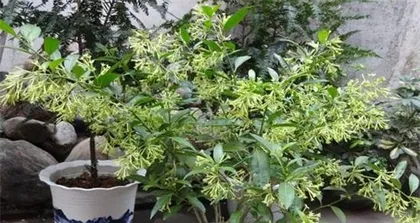Sandalwood bonsai is a highly ornamental bonsai, but to keep it healthy and beautiful, it requires proper care. This article will detail the care methods and precautions for sandalwood bonsai, hoping to help bonsai enthusiasts create a healthy and beautiful sandalwood bonsai.

Choosing the right potting soil
Selecting the appropriate potting soil is a crucial factor for the healthy growth of a sandalwood bonsai. Generally, sandalwood prefers loose, well-aerated, and well-draining soil. We can choose a potting soil mixture made by combining sand, leaf mold, garden soil, etc., in certain proportions to suit the root growth of sandalwood.
Controlling watering amount
Sandalwood prefers a humid environment, but it should not be too wet, as this can easily lead to root rot. When caring for a sandalwood bonsai, it is important to control the amount of water. Generally, keeping the potting soil moist is sufficient, and excessive watering is not necessary.

Pruning appropriately
Proper pruning can promote the metabolism and growth of sandalwood, making it healthier and more beautiful. When caring for a sandalwood bonsai, we can prune it appropriately according to its growth to maintain a relatively compact shape.
Fertilizing
Appropriate fertilization can provide adequate nutrition for the sandalwood bonsai and promote its growth. When choosing fertilizer, we can select a compound fertilizer rich in elements such as nitrogen, phosphorus, and potassium, and apply it at regular intervals.
Avoiding direct sunlight
Although sandalwood likes sunlight, excessive direct sunlight can cause its leaves to dehydrate, turn yellow, or even get scorched. When caring for a sandalwood bonsai, we should avoid direct sunlight, and can place it in a semi-shaded area or provide appropriate shading.

Preventing pests and diseases
Sandalwood bonsai is susceptible to pests such as aphids and whiteflies, which affects its healthy growth. When caring for a sandalwood bonsai, we should pay attention to regular inspections and take timely measures for prevention and control once pests are found.
Maintaining ventilation
Maintaining ventilation is an important condition for promoting the healthy growth of a sandalwood bonsai. When caring for a sandalwood bonsai, we can place it in a well-ventilated area to maintain air circulation and prevent root blockage.
Paying attention to temperature changes
Sandalwood prefers a warm environment, but it cannot be too hot or too cold, otherwise it will adversely affect its growth. When caring for a sandalwood bonsai, we should avoid sudden temperature changes, especially taking warming measures in winter.
Adjusting humidity
Sandalwood prefers a humid environment, but excessive moisture can easily lead to root rot. When caring for a sandalwood bonsai, we should pay attention to adjusting the humidity appropriately, which can be done by using a humidifier or placing a layer of stones at the bottom of the pot to promote drainage.
Regularly replacing the potting soil
Sandalwood bonsai grows relatively fast, which can easily lead to nutrient loss in the potting soil, so it needs to be replaced regularly. In general, replacing the potting soil once a year is sufficient.
Avoiding strong winds
The leaves of a sandalwood bonsai are relatively tender and can be easily damaged by strong winds. When caring for a sandalwood bonsai, we should avoid placing it in areas with strong ventilation, and take appropriate preventive measures, especially during typhoon weather.
Paying attention to dust prevention
The leaves of a sandalwood bonsai are prone to accumulating dust and stains, which affects its appearance. When caring for a sandalwood bonsai, we should regularly wipe and clean it to keep it clean and hygienic.
Cultivating healthy roots
Healthy roots are an important condition for ensuring the healthy growth of a sandalwood bonsai. When caring for a sandalwood bonsai, we should pay attention to appropriately pruning the roots to maintain their healthy and orderly growth.
Choosing a suitable environment
The growing environment of a sandalwood bonsai is also an important factor affecting its growth. When caring for a sandalwood bonsai, we should choose a suitable environment, avoid placing it in heavily polluted areas, and especially avoid exposing it to harmful gases such as car exhaust.
Caring for a sandalwood bonsai requires attention to many aspects, including choosing the right potting soil, controlling the amount of water, pruning appropriately, and fertilizing. At the same time, we also need to pay attention to avoiding direct sunlight, preventing pests and diseases, maintaining ventilation, adjusting humidity, and other aspects to ensure the sandalwood bonsai is healthy and beautiful.